





Occasionally gardeners come across intriguing plants in unexpected ways. Such was the case with my first encounter with yellow butterfly vine. Clusters of yellow, orchid-like flowers about an inch in diameter shared space with chartreuse, butterfly-shaped seedpods attached to an attractive green vine. That was enough for me to purchase the plant and learn more about it.
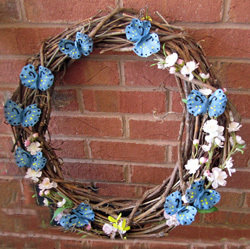 The vine that attracted my attention is Callaeum macropterum syn. Mascagnia macroptera. Hailing from Baja, California and Mexico, this plant is also sometimes called butterfly pea vine, yellow orchid vine, or gallinita. The seller of the vine knew how to attract the attention of a person who frequently works with children in junior gardener programs. She had constructed several grapevine wreaths and decorated them with painted seedpods. "What fun a fun project for my junior gardeners!" I thought.
The vine that attracted my attention is Callaeum macropterum syn. Mascagnia macroptera. Hailing from Baja, California and Mexico, this plant is also sometimes called butterfly pea vine, yellow orchid vine, or gallinita. The seller of the vine knew how to attract the attention of a person who frequently works with children in junior gardener programs. She had constructed several grapevine wreaths and decorated them with painted seedpods. "What fun a fun project for my junior gardeners!" I thought.
I bought a couple of the vines and brought them home. Other pursuits have kept me away from the garden for most of the summer, so they remain in their gallon containers growing happily up an improvised support. Nonetheless, they have bloomed all summer. Having waited this long, I will most likely place them in the greenhouse to overwinter. Next spring I will plant them out and expect them to be well enough established to endure my zone 8b winter. Although the tops may be frozen, I will expect them to grow back from the roots when warm weather returns.
Growing Specifics
Evergreen scrambling, trailing, or climbing depending on whether or not a support is offered, the butterfly vine grows 10 to 15 feet tall and is attractive from spring through fall. Generally a heavy bloom is produced in the spring and a lighter one in the fall. However, the chartreuse butterflies that gradually turn tan and then dry to an attractive dark brown decorate the vine throughout the season. 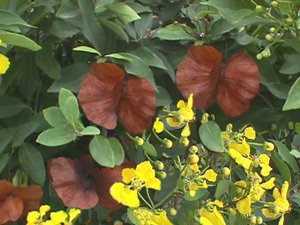
Evergreen in areas with mild winters, this frost sensitive vine dies back to the ground in Zones 8 but resprouts from the roots in spring. North of Zone 7 hardiness is dicey, but that does not preclude it from being grown as an annual vine farther north. Quick growth and early bloom will still provide a summer's worth of color and a good crop of "butterflies." Plants are generally hardy as long as temperatures do not drop below 20 to 25°F.
Train this easy-to-grow vine up a trellis, fence, arbor, mailbox, light post, or other support. Unsupported, the plant is a scrambling or trailing vine that will spill from a container or grow into a loosely mounding shrub with a bit of judicious pruning. If left to its own devices, it will make a loose, spreading groundcover.
Water newly planted vines regularly until well established. After that time little care will be required by this drought-tolerant plant. Heat tolerance is outstanding, allowing it to flourish in sunny, western exposures with reflected heat during the summer or growing up a mailbox between the pavement and sidewalk in unrelenting sun. Full sun and rich soil are preferred, but a decent performance can be expected in partial shade and almost any soil as long as it is well drained.
Propagation
Layering is the easiest way to start new vines. Simply place a vine on the ground and cover it with soil. Cuttings also root readily. Propagation by seeds is a bit more challenging. Some seeds seem not to be viable, and the papery pods rot if soil is too wet. The seed is contained in the butterfly "body." Viability can be checked by rolling it between your fingers. An old seed will crumble, but a good seed will not. Germination is erratic, and seedlings may appear over a wide range of time with some appearing in as little as a week and others taking a month or more.
Cautions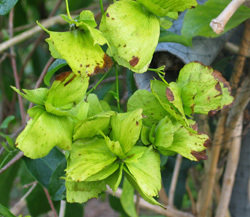
While few gardeners have reported problems with the yellow butterfly vine, some report that it is aggressive in certain conditions. One reader of Dave's Garden reported that it had spread into a nearby woodland and covered shrubs and other plants. Another source reports that it must be pruned regularly to keep it in bounds.
Nevertheless, yellow butterfly vine is vigorous, pest resistant, unpalatable to deer, and attractive. I am excited with the idea of "butterflies" that stay green if harvested while still young or turn brown if left on the vine. I believe that my junior gardeners will have a plethora of butterflies to paint and use in various craft projects next summer and fall. What fun we'll have!
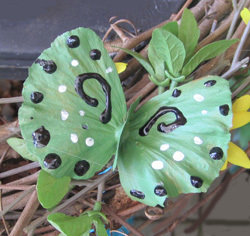
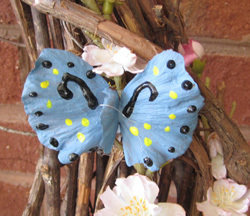
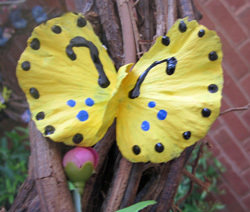
Copyright © www.100flowers.win Botanic Garden All Rights Reserved